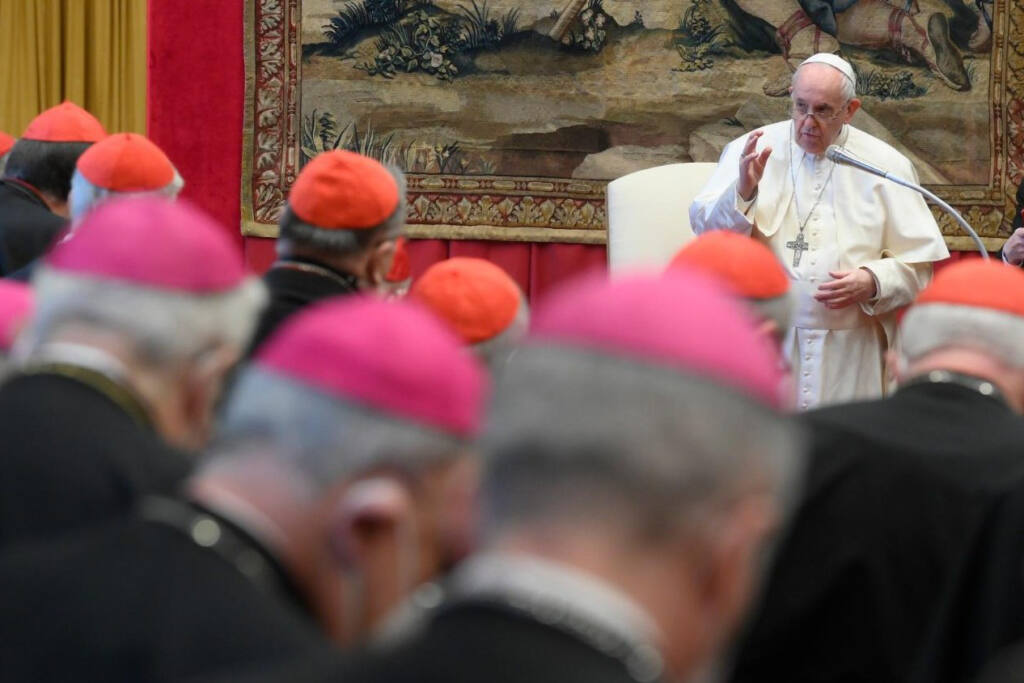
WelCom April 2022
Since Pope Francis was elected Pope in 2013, work has been going on to reform the bulky and inefficient Vatican bureaucracy, known as the curia. In March this year, Pope Francis issued a new, 54-page constitution called Praedicate Evangelium (Proclaiming the Gospel) which will usher in major reforms to the Vatican’s central administration. The apostolic constitution was released after nine years in production by the Pope’s Council of Cardinal Advisers.
Praedicate Evangelium enshrines much of Pope Francis’ broader vision for the Church into the statutes of its governing body.
New mega-departments for evangelisation and charity will be created, with the Pope taking personal charge of the former. The Pope envisions a curia that functions as an outward-reaching body that is close and connected to local bishops. ‘The Roman Curia’, says the document, ‘does not place itself between the Pope and the Bishops, rather it places itself at the service of both in the manner that is proper to the nature of each.’
The method for accomplishing this vision, for Pope Francis, is ‘synodality,’ allowing the curia, and the Church as a whole, to become one ‘of mutual listening in which each one has something to learn.’
A very noteworthy reform is the Pope’s decision to open up top Vatican leadership roles to any baptised lay person, including women.
To this end, the constitution states that ‘the Pope, the bishops, and other ordained ministers are not the only evangelisers in the Church,’ and because of this, the curial reform ‘must provide for the involvement of lay people, even in roles of government and responsibility.’
A very noteworthy reform is the Pope’s decision to open up top Vatican leadership roles to any baptised lay person, including women.
Calling the presence and contribution of lay people ‘essential,’ the document says, ‘any member of the faithful can head a dicastery or organism,’ if the Pope decides they are qualified and appoints them.
The reforms will see a rationalisation of Vatican Curia departments, joining together departments whose purpose is similar or complementary. The Vatican’s main departments are now known as dicasteries. The top three dicasteries under the new curial structure are: Evangelisation, the Doctrine of the Faith (CDF), and the Service of Charity.
Another significant change is incorporating the Pontifical Commission for the Protection of Minors into the curia as an independent office within the CDF, which will continue to operate with its own rules and its own president and secretary.
American Cardinal Sean O’Malley of Boston, who oversees the commission, praised the decision to incorporate it into the CDF, saying, ‘For the first time, Pope Francis has made safeguarding and the protection of minors a fundamental part of the structure of the Church’s central government.’
The curia has long been seen as a place where ‘pastoral drive goes to die’, as priests often get stuck in their Vatican posts for decades, having little to no pastoral experience at all. Some get lost in the inner workings of the Vatican’s bureaucratic machine while others attempt to climb the ladder to more prominent positions in and around the Vatican curia.
In moves aimed at combatting this cycle of dysfunction, apathy, and careerism, Pope Francis has implemented several changes, including strict term limits for curial officials.
The Pope stresses the importance of fostering a stronger spiritual environment within curial departments through moments of common prayer and spiritual renewal, and the periodic celebration of Mass for department members.
He also calls for more careful attention to be devoted to the selection and training of staff to ensure those who work in the curia are qualified.
The new constitution also requires that department officials must be, to the extent possible, from different parts of the world so that the curia ‘reflects the universality of the Church’.
Pope Francis has set a five-year term limit for department prefects, secretaries, undersecretaries, and other major officials.
In terms of employee turnover, Pope Francis has set a five-year term limit for department prefects, secretaries, undersecretaries, and other officials. These mandates can be extended if the Pope deems it necessary.
The constitution was issued on March 19, the Solemnity of St Joseph, husband of the Blessed Virgin Mary, the ninth anniversary of the inauguration of Pope Francis’ pontificate. It will take full effect on June 5, the Solemnity of Pentecost.
Sources: CruxNow, CNA News